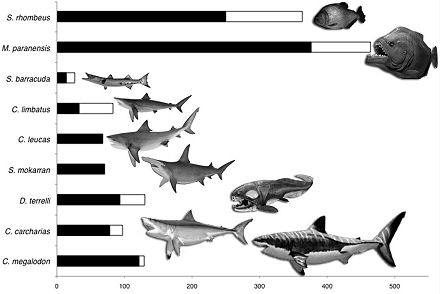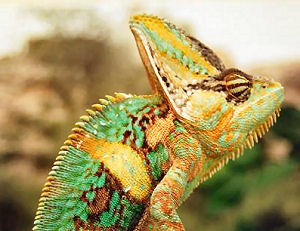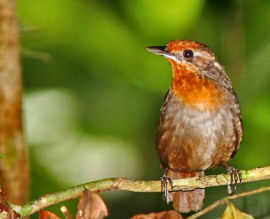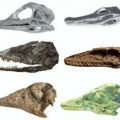
The bite force of Megapiranha, which lived 10 million years ago, was extrapolated from the first ever field measurements of the biting force of Earth’s largest piranha today,Serrasalmus rhombeus, or the black piranha. One 2.5 pound fish delivered a bite with a force of 320 newtons, or about 72 pounds, which is 30 times its body weight. The force is nearly three times greater than the bite force of an equivalent size American alligator.
Based on today’s piranha and other specimens tested in the wild, the scientists calculate that Megapiranha paranensis could have had a bite force anywhere from 1,240 to 4,750 newtons – or 280 to 1,070 pounds – and possibly more. While it’s estimated that T. rex slammed its jaws shut with 13,400 newtons, or 3,000 pounds of force, the researchers note that’s nowhere near the 30-times body-weight ratio delivered by Megapiranha.
Crofts said that pound for pound, Megapiranha and black piranha have the most powerful bites among carnivorous fishes, living or extinct. “For its relatively diminutive size,Megapiranha paranensis‘ bite dwarfs other extinct mega-predators – including the enormous whale-eating Carcharodon megalodon and the monstrous Dunkleosteus terrelli, a four-ton armored fish.

 Crofts (pictured) said the black piranha’s bite is so powerful in part because of its massive jaw muscles and rope-like tendons that together account for 2 percent of the fish’s overall weight. Further, the shape of their jaw has evolved into a powerful lever, “one of the highest jaw-closing mechanical advantages ever identified in fishes,” she notes.
Crofts (pictured) said the black piranha’s bite is so powerful in part because of its massive jaw muscles and rope-like tendons that together account for 2 percent of the fish’s overall weight. Further, the shape of their jaw has evolved into a powerful lever, “one of the highest jaw-closing mechanical advantages ever identified in fishes,” she notes.
Megapiranha’s actual diet remains a mystery, but during the time when they lived, many potential prey species were gigantic. “Thus it is reasonable to assume the food resources available to Megapiranha would likely have required jaw forces and dental weaponry capable of capturing and processing very large prey,” the paper concludes.
Related:
Discuss this article in our forum
Inch-long fleas tormented dinosaurs
Second virgin birth by shark confirmed
Loss of top predators causing widespread ecosystem disruption
Shark attack stats highlight risk of B&W Speedos









Comments are closed.